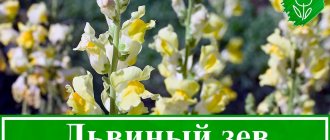Many people know this popular, short-lived perennial from the plantain family. Modern varieties are long-flowering plants with double petals, different colors and shapes, characterized by a pleasant smell. The flower is often grown in rural gardens and summer flower beds. When to plant snapdragons, growing from seeds, care after planting and other aspects of plant care are described in this article.
Types and popular varieties
Ruby red
Snapdragon can be divided according to the height of its shoots:
- Miniature - the height of the shoots is less than 20 cm.
- Low-growing - shoot height from 25 cm to 40 cm.
- Medium height - shoot height from 40 cm to 60 cm.
- Tall - shoot height more than one meter.
Let's look at some popular varieties.
Ruby
An annual tall hybrid plant, the height of which reaches 80 cm. It is grown both by seedlings and by sowing in the ground. Leaves and shoots are bright green. The flowers are two-lipped, bright red. The inflorescence looks like a brush. It blooms all summer, from June until frost. In order for new buds to form more abundantly, it is necessary to remove old faded ones. This variety is planted in flower beds and ridges. Looks good as separate islands in the garden. Perfect for cutting.
Handsome dwarf
A miniature variety, the height of which does not exceed 18 cm. The bushes have a lot of foliage, and above it a beautiful brush is formed, consisting of blood-red, almost burgundy flowers. Planted in balcony boxes, along the edges of flower beds and lawns.
Peach with cream
The plant belongs to the low-growing varieties. Height is about 25 cm. The color of the flowers is unusual - creamy peach. The bush is small and compact. The leaves are oval, the flowers are very large. Each bud can live more than 10 days. They are used in most cases as a border plant, as well as for decorating balconies.
Sneppy F1
A hybrid belonging to medium-sized varieties. Height is about 50 cm. The bushes are small, about 20 cm wide. The flowers are small, of a beautiful pink color, forming a neat panicle. It blooms for a very long time until the snow.
This hybrid is planted in balcony boxes, flower beds and ridges.
Madame Butterfly
An annual, tall hybrid. The height of the bush is more than 75 cm. The width of the bush can grow up to 40 cm.
The inflorescences, like those of other varieties, look like a brush, have a delicate aroma and a variety of flower colors. It blooms very profusely and for a long time.
Planted in flower beds and individual plantings. Keeps well when cut.
Floral Showers
Low growing hybrid plant. About 18 cm high. The bushes are not large. The leaves are bright green. The flowers form racemose inflorescences. The color of the flowers is a combination of honey-yellow and red.
Grown in flowerpots and flower pots, as well as for border decoration.
Candy Showers
An ampelous annual plant. Grown in pots and as a ground cover plant. Burgundy-red flowers pair well with bright green foliage.
Volcano
Tall plant. Height 75 cm. The bush resembles a regular pyramid. The racemose large inflorescences have a strong aroma. The flowers are painted in all shades of yellow.
Tip-top
Tall plant. The height of the shoots is about 80 cm. The racemose inflorescences consist of unusually beautiful pink flowers with a honey-yellow border. The variety is good for making bouquets and for decorating flower beds.
Rose
This variety is very common among gardeners. The bush is tall, about 1 m in height. The flowers are beautiful pink. Perfect for bouquets and garden decoration.
Velvet giant
Tall plant. The height of a regular bush is about 85 cm. Dark red flowers form loose inflorescences. This variety is not prone to lodging even in strong winds.
General acquaintance with photos
Snapdragon is a flowering subtropical crop of herbaceous, less often semi-shrub form, which, due to its poor winter hardiness, grows in Russian gardens in the middle zone with one condition - it has to be replanted every year. It has erect, finely furrowed, branched stems, the height of which can vary within significant limits - from dwarf and low-growing varieties of no more than 15 cm to tall and gigantic representatives of the genus, which manage to reach 1.5 meters in height during the season. The plant forms a pyramidal crown, the upper leaves are arranged alternately, in the lower tier - opposite. The shape of the leaf blades is lanceolate or elongated oval, and can be colored from a pale green tone to a rich herbaceous color with red veins.
When to sow snapdragons for seedlings
It should take approximately one and a half to two months from germination to mature seedlings that can be planted in open ground. Based on this, you can calculate when it is necessary to sow lion sowing seeds for seedlings. Of course, this will be a different time in each region.
- So in the southern regions, already in mid-April, snapdragon can be planted in a permanent place in the flower garden; therefore, it is planted for seedlings at the end of February.
- In the Moscow region and central Russia, seedlings will need to be planted in mid-May or a little later, therefore, in mid-March it is necessary to sow Antirrinum for seedlings.
- In the Urals, Siberia and the Leningrad region, it will be necessary to plant it even later by a couple of weeks, therefore, the sowing time for snapdragon is postponed by half a month and it is planted for seedlings in late March early April.
According to the Lunar calendar in 2022
Many gardeners won’t even take a step without the Lunar calendar. This also applies to planting Snapdragon. The table shows favorable and unfavorable days for sowing snapdragon in 2020.
| Month | Favorable days | Unfavorable days |
| February | 2-3, 6-7, 24-25 | 9-10, 21-23 |
| March | 2-3, 27-28, 30-31 | 7-9, 24-26 |
| April | 1-2, 6-7, 24, 28-29 | 8, 21-23 |
| May | 2-6, 15-17, 20, 21, 25-31 | 7, 13-14, 22 |
| June | 2-4, 7-9, 11-14, 16-19 | 5, 9-11, 21 |
Favorable days for planting
Favorable days for planting snapdragons are calculated quickly. The standard planting period is 50-60 days after the appearance of the first seedlings. It is worth remembering that seedlings appear in 7-12 days. Days are calculated based on the lunar day and growing regions. It is recommended to plant snapdragons according to the lunar calendar in 2022 during the growing phase. The new moon and full moon are considered unfavorable days for planting.
| Month | Day | |
| Waning moon | Waxing Crescent | |
| January | 11-24 | 1-9, 26-31 |
| February | 10-22 | 1-8, 24-29 |
| March | 10-23 | 1-8, 25-31 |
| April | 9-22 | 1-7, 24-30 |
| May | 8-21 | 1-6, 24-31 |
| June | 6-20 | 1-4, 22-30 |
| July | 6-19 | 1-4, 21-31 |
| August | 4-18 | 1-2, 20-31 |
| September | 3-15 | 1, 18, 30 |
| October | 3-15 | 1, 17, 30 |
| November | 1-14 | 16-29 |
| December | 1-13 | 15-29 |
The waxing moon, unlike the waning moon, saturates the seedlings with strength for further growth. The list of favorable days is not the ultimate truth. Depending on the condition of the soil, weather and seedlings.
These flowers can be planted not only on suitable dates, but also on any other dates, except those that are considered unfavorable. Planting by region requires a special approach. The optimal time for sowing is noted in February - March, but it is worth making allowances for the climatic characteristics of the growing region. It must be remembered that sowing is carried out when the frosts have already ended. However, the deadlines for each region will be different.
| Region | Deadlines |
| Southern regions | Late January - February, planted in the flower garden on the 20th of April. Sowing in open ground should be carried out in the spring, when there is no longer frost. |
| Moscow region and middle zone | End of February - first ten days of March. Transplanted into beds in mid-May |
| Leningrad region | March 20-31 or April 1-10 |
For the Urals and Siberia, the deadlines will be the same as for the Moscow region and the Leningrad region. Favorable days for planting occur in the second ten days of March - April, and on unfavorable days it is worth paying attention to preparatory work.
Unfavorable days for planting
| Month | Day |
| January | 1-8, 29-31 |
| February | 1-7, 27-29 |
| March | 1-7, 28-31 |
| April | 1-6, 27-28 |
| May | 1-4, 25-26 |
| June | 1,3, 12, 24, 28 |
| July | 1-5, 26-30 |
| August | 20, 23, 25 |
| September | 12-15, 28-29 |
| October | 3-7, 22-23 |
| November | 4, 16, 19, 25 |
| December | 5-8, 19-22 |
It is not worth sowing snapdragons on unfavorable days, because... this will not lead to the desired result. Bad days should also be avoided.
How to grow seedlings at home
There is an opinion that Snapdragon can be planted directly in open ground. Of course, it’s possible, but flowering will occur a couple of months later, and this is already the end of summer. And in the fall, frosts may occur, so in order to enjoy the modest beauty of this flower, it is better to plant it through seedlings. And for this you need to prepare containers, soil and, of course, the seeds themselves.
Preparing soil and containers
Snapdragon is not picky about soil. Any fertile soil will do. You can buy universal soil for flowering plants at the store, or you can prepare the soil for seedlings yourself. To do this take:
- Garden soil - 3 parts;
- Garden soil - 3 parts;
- Peat – 3 parts;
- Sand – 1 part.
Snapdragon loves the ground near coniferous trees. Therefore, it is useful to add such soil to the composition of the prepared soil.
Before sowing, the soil must be disinfected. Heat it in the oven or pour boiling water over it. Then you can treat it with a weak solution of manganese.
Plastic containers, disposable cups or special boxes for seedlings are suitable as containers. The height of the container must be at least 10 cm. They must also be washed with hot water and treated with a solution of potassium permanganate.
It is very convenient to sow snapdragon seeds in peat tablets. Before use, the tablets must be soaked in a small amount of water to swell.
Ampelous petunia: growing from seeds at home
Selection of seeds and preparation for sowing
Before sowing seeds, you need to decide whether you want to get a tall or small plant. Use flowers for cutting or admire them in compositions created in the garden. Based on this, you need to choose a flower variety.
Before sowing, seeds must be treated in a weak solution of manganese and soaked for several minutes in a growth stimulator. This will help you get healthy and strong seedlings.
Sowing
Drainage is poured into the bottom of the prepared container; it can be small pebbles or coarse sand. Then the prepared soil is placed. Make shallow furrows in the soil every 3-4 cm, and lightly moisten the soil with a spray bottle. The seeds are mixed with sifted sand and sown in the furrows. Sprinkle a thin layer of sand on top and moisten again.
Cover the container with film or glass and put it in a warm place. The temperature should be at least 18-20 degrees Celsius. All that remains is to wait for the shoots to appear. They will appear in about a week and a half. If the soil dries out during this time, it is moistened. The plantings must be ventilated every day by raising the shelter for a few minutes.
Snapdragon, sowing seeds for seedlings - video
How to prepare planting material for sowing
Before planting grains in the ground for growing Antirrinum seedlings, they are prepared. The preparation process usually includes 2 procedures: disinfection and stimulation.
You can disinfect the seeds by soaking them for half an hour in a pink solution of potassium permanganate or a solution of hydrogen peroxide (a teaspoon per glass of water).
Stimulation includes soaking planting material in a growth stimulator (Epin, hydrogen peroxide, Gumi, aloe juice, etc.).
Unlike other flowers, Antirrinum grains do not require long soaking. It is enough to keep the seeds in gauze soaked in a nutrient composition for just 2 hours.
Seedling care
Snapdragon seedlings require no more attention than any other seedlings.
Temperature and lighting
After the seedlings appear, the container with the seedlings is placed on the window, slightly shaded so that the hot rays of the sun do not destroy the tender sprouts. The cover from the container must be removed gradually. For a week, remove the film for a few minutes a day, increasing the time.
If there is little natural light, the seedlings should be illuminated with lamps.
Watering
Seedlings should be watered sparingly as the top layer dries. Moistening is carried out carefully along the edge of the container using a spoon or by pouring water into a tray.
Picking
When 3-4 true leaves are formed, the seedlings must be pruned. To do this, use larger containers. Plants are planted at a distance of 5-6 cm. If the seeds were sown in a peat tablet, then it is simply placed in a container (after removing the protective mesh from it) and sprinkled with earth. The pick can be done again, but now the distance between the holes will be at least 10 cm.
Geranium: home care for beginners
Feeding
A week after picking, it is necessary to carry out the first fertilizing with mineral fertilizers. It is best to apply a complex fertilizer containing nitrogen, phosphorus and potassium. It is best to fertilize leaf by leaf. This feeding will help the plant develop better and flowering will be more abundant. Subsequently, feeding should be done every 2-3 months.
After the seedlings grow, they need to be pinched. This will give even more shoots, and the bush will be more lush, therefore, there will be many more flowers.
Hardening
As soon as the seedlings get stronger, they need to start hardening off. To do this, take it out to the balcony or terrace for a short time, or you can simply open the window. Harden for a week, adding five minutes each time you open the window.
Important! Do not allow drafts, which can destroy the plant.
Bloom
The two-lipped snapdragon flowers have an irregular shape with swollen petals on the lower lip, hence the plant's name. The inflorescence is spike-shaped, with flowers of a simple or double type in artificially bred varieties. Their color is very diverse - all shades of red and pink, white, yellow, beige, fawn and others. 2-3-color varietal varieties have also been bred. Flowering begins closer to mid-summer and lasts until the first autumn cold arrives on the site. The fruit is a two-locular polysperm, in which a huge number of small seeds ripen. In total, 1g can contain up to 8 thousand pieces.
Some released varieties of snapdragon are able to overwinter under good cover and grow as a perennial. But most often only until the first extremely cold and little snow winter.
When to transplant seedlings into open ground
After the soil has warmed up, the hardened seedlings can be planted in open ground.
Transplant timing
Snapdragon is a cold-resistant plant. Therefore, already in mid-May, seedlings can be planted in the garden. But if there is a threat of return frosts, the plantings should be covered with covering material.
Selection of location and soil
Antirrinum prefers sunny places, but it will also grow well in light partial shade, but the flowering will be less lush. Snapdragon loves light, loose soil. If the site is dominated by clay soil, sand, dolomite flour or wood ash should be added to it. Snapdragon looks great along paths and in flower beds. They are also good cut.
Seedlings should be planted in prepared holes, placing the plant in them along with a lump of earth. The distance between the holes should be from 20 to 50 cm, depending on the variety:
- Low-growing ones are planted at a distance of 20 cm.
- Medium height at a distance of 25-30 cm,
- Tall at a distance of 45 cm.
After planting, the plants are moistened and mulched with peat or grass.
How to plant eustoma seedlings correctly
Reproduction methods
Antirrhinum is usually grown from seeds. In warm climates, you can sow them directly into open ground. In the middle zone, the seedling method is preferable. Watch the video: how to properly sow seeds and care for seedlings.
Cuttings are one of the possible methods. But it is usually used by breeders to obtain a new variety with double petals. A selection of powerful, healthy bushes is carried out. They overwinter indoors. The cuttings are planted in the sand until roots appear.
Caring for flowers after planting
In the future, the plants require weeding, loosening, watering and the application of mineral fertilizers. Watering should be moderate but constant. If for some reason it was not possible to water the plant, then after watering it will quickly recover, but you should not abuse this. Flowering may be greatly reduced. And in some cases it will even shed its flowers. It is better to water the plant at the root; its delicate flowers may not tolerate excessive moisture.
Flowering of Snapdragon occurs in waves. That is, one wave fades, and the next one immediately begins to bloom. Faded flowers must be removed so that the new wave of flowering will be even more magnificent.
Annual dahlias - planting and care
Interesting Facts
- The name of the plant is translated from ancient Greek as “nose-like.”
- According to legend, the flower was given to Hercules for his victory over the Nemean lion.
- In Russia, Antirrinum is called “dogs”, in France – “cleft mouth”, in England – “biting dragon”.
- In the USA, snapdragon is one of the most popular flowers used in bouquets.
- The dried fruit capsules of Antirrinum look like human skulls.
Growing problems
The main problems can arise after severe or constant waterlogging. Against this background, Snapdragon can get sick with various diseases:
- Fusarium wilt;
- Verticillium wilt;
- Rust;
- Blackleg;
- Septoria;
- Downy mildew;
- Root and stem rot.
Snapdragon is also often affected by pests:
- Gall nemethod;
- Aphid;
- Ticks;
- Sofka;
- Slugs.
For prevention purposes, you should not thicken the plantings. And if the plants are already sick, then they must be disposed of immediately so as not to infect those growing nearby.
Advice from flower growers
Flower growers advise watering the plant only with warm water, and not with cold water, in order to avoid many diseases. The air temperature and water temperature should be the same.
Insecticides can be used to control pests.
If you replant Snapdragon several times, this will greatly strengthen the root system.
Snapdragon seedlings do not need to be pinched. Plant it in a permanent place and then you can pinch it.
You can try to save the variety you like. To do this, the plant you like is carefully dug up, planted in a pot and cared for in winter as if it were a potted plant.
The hanging varieties of Lion's Sowing look very decorative.
Collecting seeds
To collect seeds, shoots are left after flowering; they are collected in the incomplete ripening phase. The green top is cut off, a paper bag is put on the arrow and tied at the bottom. Next, the peduncle is cut off and hung in a bag; when the seeds ripen, they will pour into it themselves.
Seeds can be stored for 3 years in a dry room with an air temperature of 3-5˚ C.











